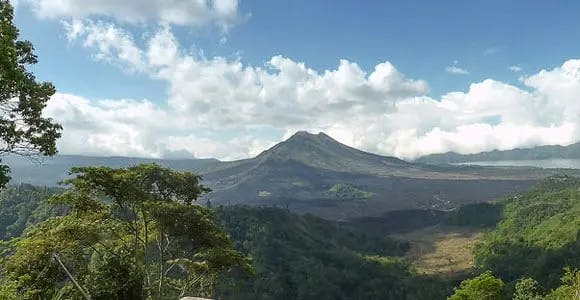By Josephine Brierley
One of the earliest beach resort towns in Bali, Sanur doesn’t have the hustle and bustle of Kuta or Legian. Quite the opposite in fact, traffic is slow and traditional everyday Bali life lingers and with its relaxed vibe, making it a great location for expats. Situated on the south-eastern tip of Bali, Sanur is a 30-minute drive away from the airport, six miles away from Kuta, and yet still retains its village feel. It’s really easy to fit in with the local and expat community in Sanur, with many casual restaurants, cafes, and bars for networking. You are never far from the beach, but your morning walk could also take you by lush watermelon gardens and rice paddies.
Protected by an offshore reef a few miles out to sea, the oceanfront in Sanur is more a lagoon, perfect for ocean swims and activities. Small waves lap at the shoreline, where the brightly colored traditional fishing boats (Jukung) line the sand, with sandbanks appearing on low tide.
Lifestyle in Sanur, Bali
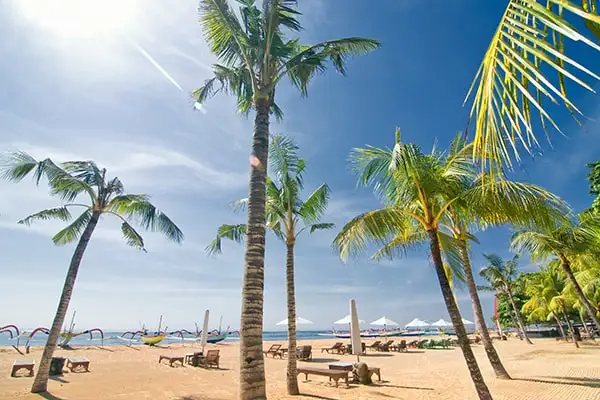
Whether you live beachside or on the western side of the main road, you’ll always have easy access to the beaches. Admittedly, crossing the busy road is a nightmare at times, but it’s doable, the medium strip has cut-outs that allow you to cross when traffic slows. From there you can reach the ocean within five minutes. A three-mile paved path runs from Mertasari beach in the south to Sanur beach in the north. It is perfect for a leisurely bike ride or a walk anytime of the day, the path is not too crowded most of the time and there are plenty of places to stop for coffee or a cold drink along the way.
Differing from other tourist hotspots on the island, Sanur has managed to retain its traditional Balinese ambiance despite its early origins. It’s common to see women walking to the temples to perform their daily rituals with towering offerings on their heads, the brightly colored fishing boats rest on the sand, and you’ll often find fisherman returning to shore with their daily catch. Traffic only comes to a standstill when there’s a procession through the streets.
With over 300 options, you’ll be spoiled for choice when it comes to eating and drinking. There are many restaurants and cafes along the promenade, and most of them open from early morning to late at night, so every meal is covered. The night markets located on Jalan Tamblingan are a great way to sample local foods cheaply and to soak up the atmosphere. One favorite is the Martabak vendor. Pastry rolled thinly and placed on the hot pan, then an omelet type mixture is prepared filled with vegetables and chicken. Poured on top, the pastry is folded over the omelet as it’s cooking. Once done it’s sliced up and served, it’s delicious and feeds two for $2.50.
Many expats in Bali have scooters to get around, especially if they live within the tourist areas. Riding a bike helps to sneak around traffic that sometimes clogs up the streets and they’re cheaper than a car to own and run, or rent. You can easily lease a scooter from $60 to $80 a month, depending on the type and also how well you can negotiate the price. Buying a used scooter will cost about $400 to $800 and a new one is around $1,300. Buying a car is just as expensive as back home, if not more. But renting a car is easy. A Suzuki Swift is around $250 a month and if you’re only traveling in the local area fuel will set you back about $25 a month. Currently petrol prices are around $0.65 per liter for standard fuel. There are hundreds of taxis all over, and a trip from Sanur to Seminyak is around $10. Ride-hailing apps Grab and Go-Jek offer a cheaper alternative and provide cars and motorcycles for pick up. Transport drivers are easy to find and if you use one, he’ll always be around if you need him. A private driver pick-up from the airport to Sanur is around $20; hiring a driver for an all-day tour is around $50.
There’s a variety of choice for supermarket shopping in Sanur. New to the scene is a store called Popular, where you’ll find fresh fruit and vegetables, and just-baked bread along with your pantry staples. Artesedana is another supermarket complex in the center of town, and for bulk shopping head to Lotte Mart, which is only a 15-minute drive. Located on the west side of the bypass is a chain called Pandi Putri, and they have a number of locations handy to many expat villas. Of course, the freshest and cheapest option is the local markets, held every morning. Here you can hone in on your bartering skills, mix with the locals and enjoy fresh Pisang Goreng (banana fritters) for breakfast.
Retire in Sanur, Bali
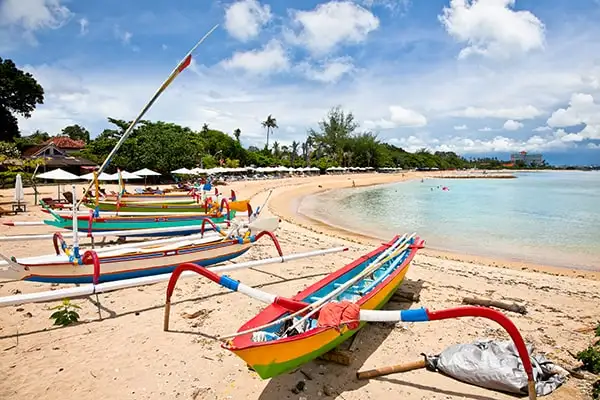
Sanur is a good choice for those who want a relaxed lifestyle. While there are a few bars open late, and a small live-music scene, Sanur isn’t known for its party atmosphere. It’s the traditional Balinese ambiance that brings people to Sanur.
As an example, a villa located in Sanur West is quite reasonable to rent on a yearly basis. It is a tradition-style property with two bedrooms, two bathrooms, and a kitchen/living area and it comes unfurnished. It has a carport, is close to local supermarkets, and a 10-minute drive to the beaches. Price: $9,000 per year.
For beachside luxury, expect to pay a little more. Located down a quiet and private lane off Jl Mertasari is a two-story villa with lockable garage. With a huge lap pool, living areas, three bedrooms, four bathrooms, and upstairs is a courtyard area suitable for a barbecue and bar. The property is only a five-minute walk to the beach. The lease has 24 years remaining taking you through to 2042. Price: $210,000. This is also available as a rental for $16,500 per year.
Bali weather does alter is some areas, but Sanur is fairly consistent. As Bali is located only eight degrees south of the equator, the weather is warm year-round. There really are only two seasons, but the temperature rarely varies between a high of 86 F and a low of 73 F. The wet season runs from late October until early March, but don’t expect the season name to stop you from enjoying any outings, it’s still warm, just very humid as well. The season begins with unexpected downpours randomly through the day, before settling in from around December through February.
Cost of Living in Sanur, Bali
Here’s a typical monthly budget for a couple:
| Item | Cost in USD |
| Rent for a two-bedroom furnished apartment | $400 to $1,000 |
| Electricity and Gas | $62 |
| Water | $7 |
| Internet/Mobile Phone/TV | $55 |
| Maid (six hours per week) | $100 |
| Eating out | $100 to $300 |
| Pool Maintenance | $40 |
| Gardener | $25 |
| Transport (car or scooter hire) | $60 to $250 |
| Fuel | $30 |
| Health insurance | $45 |
| Total | $924 to $1,914 |
Medical and Dental in Sanur
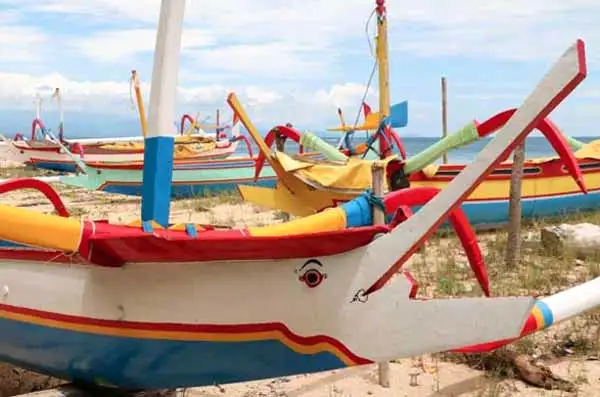
In 2016, the Bali Mandara hospital opened in Sanur. The project was completed with support from the Royal Darwin Hospital to ensure development to international standards. It’s provided medical care to locals and expats without having to travel too far from Sanur.
BIMC Hospital is located in Kuta, a 30-minute drive away from Sanur and also comes recommended for expat care. For small issues, there are two local clinics. Mutiara Medika Clinic is located on Jalan Sekuta in Sanur. A check-up and blood pressure medication costs under $20 monthly. Gopa Medical is located on Jalan Danau Poso. It's a little more expensive, as he’s located on the tourist strip, but his care is professional and efficient. The most recommended dental service in Sanur is Retno Wulan Agung, located on Jl. By Pass Ngurah Rai, directly opposite McDonald’s.
The Weather

Bali weather does alter in some areas, but Sanur is fairly consistent. As Bali is located only eight degrees south of the equator, the weather is warm year-round. There really are only two seasons, but the temperature rarely varies between a high of 86 F and a low of 73 F.
The wet season runs from late October until early March, but don’t expect the season name to stop you from enjoying any outings. It’s still warm, just very humid as well. The season begins with unexpected downpours randomly through the day, before settling in from around December through February.
Extended days of rain and cloudy skies are the norm, and then the wet tapers off again as March approaches. Many Balinese believe Nyepi day (a Balinese day of silence) heralds the end of the rainy season. So far, they’ve been right. The dry season runs from April through to September and is exactly that—hot, dry days with brilliant blue skies and a steady warm temperature. The eastern side of the island experiences strong winds from June to August, when it's cool enough to wear long sleeves at night on the beach.
How to Spend Your Day in Sanur
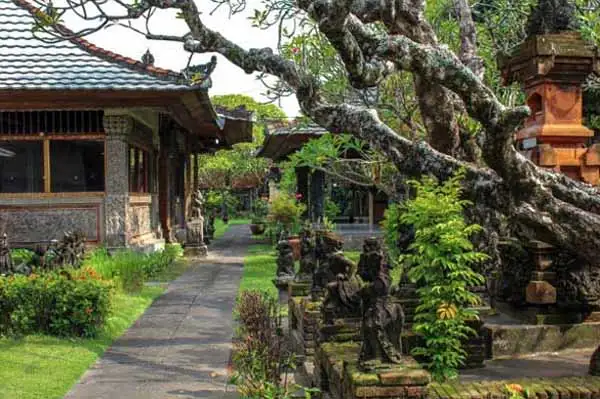
I often get asked what I do with my day. Surprisingly, I find it hard to answer. The day just passes. Breakfast is usually fruit and yogurt at home. Lunch or dinner usually isn’t planned—it just happens. If we’re at our restaurant, (Beach House Sanur ), most times we sit and chat with visitors or friends. Sanur is centrally located, which makes it easy to drive anywhere. We’re only a 30-minute drive from Nusa Dua, Kuta, or Legian. We can be in Candidasa, for lunch at Le Zat, overlooking the water, within an hour.
One place we like as an escape is Komune Beach Club. Only a 40-minute drive north to Gianyar, it’s a resort overlooking the black sands of Keramas Beach. The day club has a pool, a great restaurant, and day beds will cost you $30, with all costs being credited in food and drinks. Try the Peking duck rolls ($6.50) and the barbecue pork ribs ($15.50). Plus, the views are spectacular.
Bike hire is easy. Or if you’re staying long term, buying a pushbike will set you back around $120. It’s a great way to get around in Sanur—traffic is slow and I find it’s easy to ride along the roadside. The beach path is ideal for cyclists and it’s a great way to get some exercise.
Scooter hire and car hire is easy in Sanur; you’ll see signage everywhere. Costs to rent a car range from $250 to $350 per month, depending on the size. Scooter hire usually costs around $60 per month.
North on Padang Galak Beach is Taman Festival, a theme park which was set to open in 1997, but never did. The shells of buildings still stand and make great photo opportunities, while street artists have created some amazing murals.
The Museum Le Mayeur was once the home of Brussels artist Adrien-Jean Le Mayeur de Merpres. The home now features his art and showcases classic Balinese architecture. You’ll find it just north of Sindhu Beach. It’s open Monday to Friday only.
The Blanjong Temple, on Jl. Danau Poso, houses one of the oldest relics in Balinese history. The Blanjong pillar is etched with Sanskrit inscription and is said to date back to the 10th century.
From June to September, be sure to look up! The skies are filled with kites, particularly during July, when the Bali Kite Festival is held. Large trucks are used to transport the kites, which are usually works of art and can span five to 32 feet. The process of take-off and landing is just as impressive as them flying in the air and a trip to the kite festival is a must.
Things to do in Sanur

Explore: Sanur is only a 30-minute drive from Nusa Dua, Kuta, or Legian, making it a great base to explore Bali and Indonesia. Candi Dasa is only one hour away, and only a 40-minute drive north to Gianyar, Komune Resort overlooking the black sands of Keramas beach is a great day out. The day club has a pool, a restaurant, and day beds beside the ocean. Try the Peking Duck rolls ($6.50) and the BBQ pork ribs ($15.50) while enjoying the spectacular views.
Ride a Bike: Bike hire is easy, or if you’re staying long term, buying a pushbike will set you back around $100. The beach path is ideal for cyclists and it’s a great way to get around town and get some exercise in at the same time.
Visit an Abandoned Theme Park: North on Padang Galak beach is Taman Festival. A theme park, which was set to open in 1997, but never did. The shells of buildings still stand and make great photo opportunities where street artists have created some amazing murals.
History: The Museum Le Mayeur was once the home of Brussels artist Adrien-Jean Mayeur de Merpres. The home now features his art and showcases classic Balinese architecture. You’ll find it just north of Sindhu beach, it’s open Monday to Friday only. The Blanjong Temple on Jalan Donau Poso houses one of the oldest relics in Balinese history. The Blanjong pillar is etched with Sanskrit inscription and is said to date back to the 10th century.
Kite Flying: This is popular from June to September so be sure to look up. The skies are filled with kites and the Bali Kite Festival runs from July. Large trucks are used to transport the kites, which are usually works of art and can span 15 feet to 30 feet. The process of take-off and landing is just as impressive as them flying in the air and a trip to the Kite Festival is a must.
Visit Other Islands: From North Sanur beach, travel 30 minutes by boat to Nusa Lembongan. This is great for a day trip or an overnight stay. Enjoy snorkeling with the Manta Rays while you’re there. Or for a longer boat trip, head to the Gili islands where you can snorkel in the turquoise waters with giant sea-turtles.
Is it Safe to Live in Sanur?
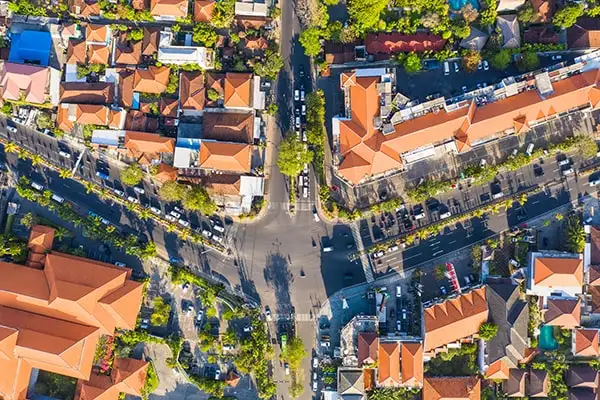
While Sanur has a laidback mood, it’s still best to be aware of your surroundings. There have been bag-snatching incidences recently, and walking alone at night is not recommended. When paying for goods, ensure you don’t flash you cash openly. Across Indonesia, it’s best to stick to bottled water, with the local water supply not safe to drink.
Indonesia is located on the Ring of Fire. While volcanoes erupting and earthquakes are infrequent occurrences, they cannot be ruled out. Just keep yourself abreast of alerts and have an exit plan if needed.







